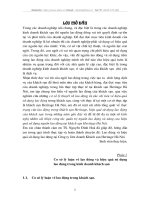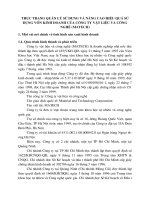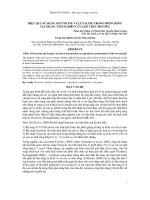SỬ DỤNG BIỂU ĐỒ TRÒN HIỆU QUẢ ĐỂ TRUYỀN ĐẠT KẾT QUẢ NGHIÊN CỨU
Bạn đang xem bản rút gọn của tài liệu. Xem và tải ngay bản đầy đủ của tài liệu tại đây (1.57 MB, 17 trang )
Effective Use of Pie Charts
Purpose This tool provides guidelines and tips on how to effectively use pie
Format charts to communicate research findings.
Audience This tool provides guidance on pie charts and their purposes, shows
examples of preferred practices and practical tips for pie charts, and
provides cautions and examples of misuse and poor use of pie charts
and how to make corrections.
This tool is designed primarily for researchers from the Model Systems
that are funded by the National Institute on Disability, Independent Living,
and Rehabilitation Research (NIDILRR). The tool can be adapted by other
NIDILRR-funded grantees and the general public.
The contents of this tool were developed under a grant from the National Institute on Disability, Independent Living, and Rehabilitation
Research (NIDILRR grant number 90DP0012-01-00). The contents of this fact sheet do not necessarily represent the policy of
Department of Health and Human Services, and you should not assume endorsement by the Federal Government.
1
Overview and Organization
General Use of Pie Charts………………………...…..3
Exploded Pie Charts ……………………………………..12
Pie of Pie Charts……………………………………………14
Pie Column Charts………………………………………..16
3-D Pie Charts……………………………………………….17
Pie Charts
The primary use of a Pie Chart is to display the
proportional relationship of various components to
a whole.
For example, a pie chart might display the relative
proportion of Social Services clients by race-
ethnicity group (for client intakes occurring in CY
2014).
A pie chart might show the proportional
composition of current social security disability
beneficiaries by eligibility category.
Pie Charts
Social Security Disabled Beneficiaries – By Eligibility Category – December 2013
Source: Social Security
Pie Charts
Chatham Food Pantry Clients – By Race-Ethnicity Group – December 2014
Included the number of
clients as well as the
proportional
representation in
each segment label
Source: Mock Data
Pie Charts
Cautions, Misuse, and Poor Use
The slices are unsorted by magnitude. Too many slices. Max recommended wedges for
Generally best to sort slices in descending a pie chart is 7 slices. Consider combining minor
order to communicate slice rank. slices. 1% and 2% slices are generally too small
The “Other” slice is usually displayed last. to display and reliably discern on a pie chart.
Don’t make the reader scan back and forth
between the pie wedges and the legend. Where
possible, incorporate the slice names and the
proportions in the slice label itself.
Pie Charts
Cautions, Misuse, and Poor Use
Chatham Food Pantry Clients – By Race-Ethnicity Group – December 2014
Multiple pie charts are inefficient and use too much space [pixels].
Somewhat difficult to compare the race-ethnicity slices across the two pies.
Pie Charts
Chatham Food Pantry Clients – New vs Repeat Clients
December 2014
Sometimes, if all you wish to convey is a simple single
high-interest proportion, then a pie chart can be effective
Pie of Pie Charts
Pie of Pie Charts often used to break out detail in a segment of interest.
Source: Social Security
Pie of Pie Charts
Referral Source for First-Time Chatham Food Bank Clients - December 2014
Pie of Pie charts also used to split out finer detail
when slice percentages are below 5% (such as the
“Media” slice in this example)
Pie Column Charts
Can also display the secondary detail data as a stacked column









